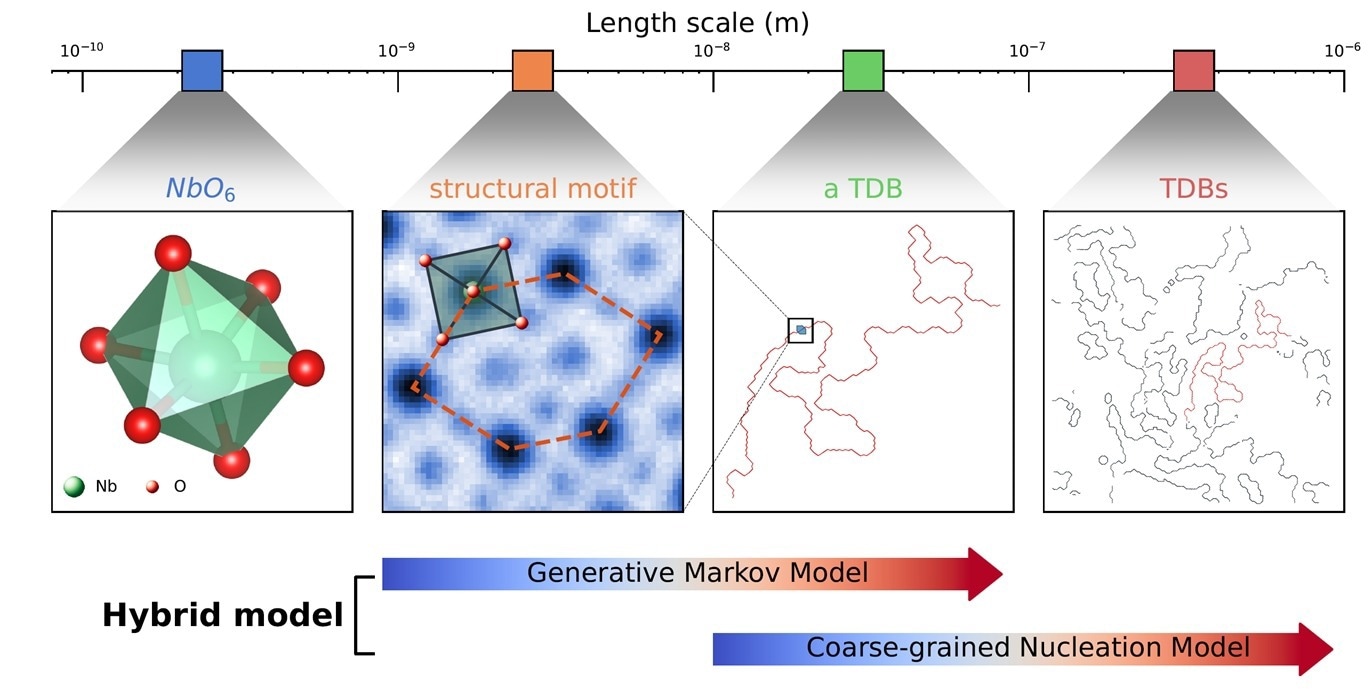Researchers at the National University of Singapore (NUS) have employed generative machine learning models to investigate the various ways in which mismatches can occur between atoms in adjacent crystals of piezoelectric materials—materials that, when subjected to mechanical stress, produce a modest electrical voltage. This discovery reveals how disorder develops in these types of materials.
 From left to right, NbO6 octahedra organize themselves into structural motifs (orange dashed lines) along the domain boundaries which, in turn, form a single domain boundary (TDB); These TDBs compete as translational domains and pack densely on the plane. This hierarchy can be described and modeled by the hybrid generative model. Image Credit: Science Advances
From left to right, NbO6 octahedra organize themselves into structural motifs (orange dashed lines) along the domain boundaries which, in turn, form a single domain boundary (TDB); These TDBs compete as translational domains and pack densely on the plane. This hierarchy can be described and modeled by the hybrid generative model. Image Credit: Science Advances
A long-standing concern in the field of materials science is whether certain structural disorders in complex materials have useful purposes. Determining the forms of disorder present in a given sample is a significant difficulty. NUS researchers overcame this difficulty by reducing a large variety of structural disorders in a piezoelectric material’s domain limits to a limited number of simple, multiscale probabilistic rules.
Using these guidelines, they developed a generative machine learning model that covered three orders of magnitude in length scales, enabling the statistical characteristics of the material to be studied beyond the boundaries of practical measurement.
The research team, led by Assistant Professor Ne-te Duane LOH from NUS's Department of Biological Sciences and Department of Physics, discovered that a surprisingly small set of simple probabilistic rules could capture the experimentally observed structural disorder along the domain boundaries of potassium-sodium niobate piezoelectric films.
These principles can be broken down into two subsets: random nuclei and Markov chains, which predominate at different length scales. For a given material sample, the ensemble of domain borders is created using these two sets of criteria.
Through the “vocabulary” and “grammar” of an interpretable machine learning model, the researchers converted these probabilistic principles into a wide range of realistic disordered domain boundaries that are indistinguishable from experimental data. This generative model made orders of magnitude more data available than would be possible through costly first-principles computations or real-world experimentation.
By using this model, the scientists were able to identify domain border motifs—which are structures resembling chains—in the material that had previously gone undiscovered, providing insight into potential influences on its piezoelectric response. Additionally, they discovered proof that these domain bounds maximize entropy.
This discovery points to the possibility of developing interpretable machine learning models that can comprehend the intricate nature of disorder in materials, opening the door to new insights into their composition and intended use.
Science Advances published the study.
The team’s continued integration of atomic resolution electron microscopy with statistical learning to scan complex materials is being carried out in this project.
Our work can be generally extended and applied to other important systems where disorder plays an essential role in controlling the physical properties of materials.
Dr. Dan Jiadong, Study First Author and Eric and Wendy Schmidt AI in Science Fellow, Centre for Bioimaging Sciences, National University of Singapore
The group also hopes to learn more about the functional significance of recently identified structural motifs, emphasizing the possibility of comprehending and creating intricate materials.
This work complements our earlier learning of atomic motif hierarchies. Together, they push us towards creating companion Artificial Intelligence (AI) alongside microscopes to provide unprecedented, fast feedback.
Ne-te Duane Loh, Assistant Professor, Department of Physics, National University of Singapore
Journal References:
Dan, J, et. al. (2023) A multiscale generative model to understand disorder in domain boundaries. Science Advances. doi:10.1126/sciadv.adj0904
Dan, J, et. al. (2022) Learning motifs and their hierarchies in atomic resolution microscopy. Science Advances. doi:10.1126/sciadv.abk1005